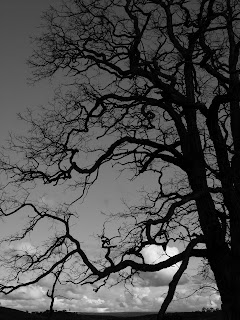 Last night, Judith and I went to see Kaidan, a Ghost Story, performed by Taikoz, Riley Lee with Meryl Tankard's contemporary dance direction, at Sydney Opera House Drama Theatre. The advertising photos do not do justice to the complex blend of rear projection, front projection on translucent curtains, integrated Taikoz players on stage mingling themselves and their instruments amongst wispy dancers and puppet-like mystery. Rather than being scary, the seasonal progression through a loose narrative and bizarre mix of humans and insectoid creatures, was disturbing, at times tortured and uneasy. I don't know much about dance but the lithe skill of the dancers seemed very intriguing and subtle. Riley shaved off his hair(!) and looked like a sincere monk in his earthy-toned kimono. J & I really like this new look and it is much better for seeing the shakuhachi embouchure (normally hidden under his caterpillar moustache!). The sets were minimalistic, rather using lighting, a sequence of video-projection (sometimes too intrusive and obvious for my taste) with fluttering objects, flowing costumes, occasional suspended scenes for dancers and different planes on the stage. Taikoz, as usual, were excellent. An ambient-like elctroacoustic backing track was composed by Tim Constable while the Taikoz music composition/direction was designed by Ian Cleworth and Taikoz. These meshed well and frequently relaxed to make space for sonorous tones of Riley's 1.8 and bigger flutes or occasional the piercing Nookan, a kind of big fue/shinobue with equally intense tone.
Last night, Judith and I went to see Kaidan, a Ghost Story, performed by Taikoz, Riley Lee with Meryl Tankard's contemporary dance direction, at Sydney Opera House Drama Theatre. The advertising photos do not do justice to the complex blend of rear projection, front projection on translucent curtains, integrated Taikoz players on stage mingling themselves and their instruments amongst wispy dancers and puppet-like mystery. Rather than being scary, the seasonal progression through a loose narrative and bizarre mix of humans and insectoid creatures, was disturbing, at times tortured and uneasy. I don't know much about dance but the lithe skill of the dancers seemed very intriguing and subtle. Riley shaved off his hair(!) and looked like a sincere monk in his earthy-toned kimono. J & I really like this new look and it is much better for seeing the shakuhachi embouchure (normally hidden under his caterpillar moustache!). The sets were minimalistic, rather using lighting, a sequence of video-projection (sometimes too intrusive and obvious for my taste) with fluttering objects, flowing costumes, occasional suspended scenes for dancers and different planes on the stage. Taikoz, as usual, were excellent. An ambient-like elctroacoustic backing track was composed by Tim Constable while the Taikoz music composition/direction was designed by Ian Cleworth and Taikoz. These meshed well and frequently relaxed to make space for sonorous tones of Riley's 1.8 and bigger flutes or occasional the piercing Nookan, a kind of big fue/shinobue with equally intense tone.Whilst mostly derivative of Japanese origins (such as the black-dressed stage assistants in kabuki, the established genre of ghost stories in Japan and Japanese puppetry - bunraku), some inter-cultural influences included Buddhist temple bells, Chinese Peking Opera gongs, marimbas and metallophones and Burmese bells, lending to the eclectic stylistic ensemble. The title stems from the Japanese ghost story, Of a Mirror and a Bell from Irish author Lafcadio Hearn's collected translations. The mirror is said to reflect a woman's soul and here, the woman's life disintegrates as she gives away her mirror. Her eventual sadness and hopelessness leads her to suicide, the curse signalled by a constantly tolling bell, subsequently sunk at the bottom of a river. The story opens and closes with the river, the source of the spirit and the story, perhaps. Very interesting show.